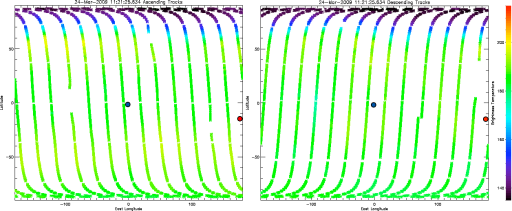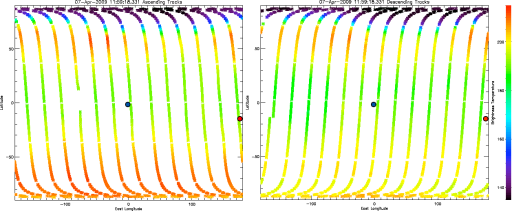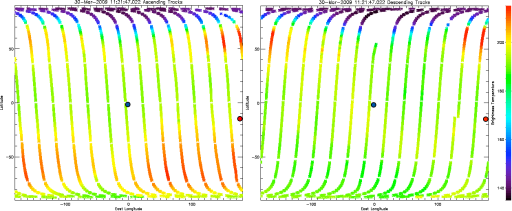Emily Lakdawalla • Apr 09, 2009
Update on the Mars dust event
It's been a week since I posted a storm warning from Mars, and I have an update with the latest data. In brief: the southern dust event is not abating, but the dust has not spilled across the equator; everything's staying in the south for now.
To quickly review, I'm talking about data hot from Mars Reconnaissance Orbiter's Mars Climate Sounder, an instrument that stares off of Mars' limb to take profiles of atmospheric properties like temperature, pressure, and dust abundance. (It's not as easy as that of course; what they measure directly is the brightness of the atmosphere at several near- and mid-infrared wavelengths, and they have to do mathematical modeling to extract the information they're really looking for.) In the diagrams below, we're basically seeing the temperature of the atmosphere high above the ground, from about 20 to 40 kilometers elevation.
Two weeks ago, Mars looked typical for the season, with a very cold spot at the north pole, and otherwise fairly uniform temperatures that don't change a whole lot from day to night.

NASA / JPL-Caltech
Mars Climate Sounder profiles of Mars' atmospheric temperature, March 24, 2009
The map on the left represents Mars Climate Sounder's observations of the day side of Mars in the local afternoon, as MRO ascended in its orbit around Mars; the map on the right is a plot of observations gathered as MRO descended on the night side. Blue and red dots mark the locations of the Opportunity and Spirit rovers, respectively. The temperature measurements come from the A3 detector, which is centered on a wavelength of 15.4 microns, where carbon dioxide is a strong absorber.This plot shows fairly typical temperatures for the season, late southern spring. There is a strong northern polar cold region (the north polar vortex) and otherwise fairly uniform temperatures (around 180 to 190 kelvins or -90 to -80 Celsius). There are a few warmer spots near latitudes of 50 north and 50 south.

NASA / JPL-Caltech
Mars Climate Sounder profiles of Mars' atmospheric temperature, April 7, 2009
Since March 30, the dust has remained confined to the southern hemisphere. It has spread all the way to the pole and to ~20 degrees south. It is now fairly uniform in longitude, except at the northern extent of the heating. The dust is now planet encircling.In the north, the dynamical heating is now at all longitudes, but does show some preference for the meridian and 180 degree regions. It is not as warm as at the peak. There is some indication that there is a high (probably thin) haze of dust in the northern hemisphere since the middle of the previous week.
Some things we can explain -- some things we can't. There's always more to learn!
Support our core enterprises
Your support powers our mission to explore worlds, find life, and defend Earth. You make all the difference when you make a gift. Give today!
Donate

 Explore Worlds
Explore Worlds Find Life
Find Life Defend Earth
Defend Earth


